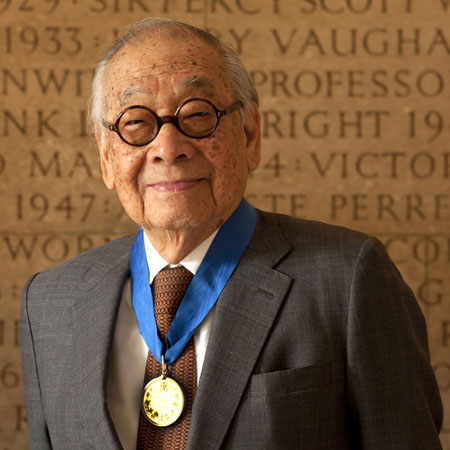Architect IM Pei will be awarded the Royal Gold Medal for architecture at a ceremony in London tonight.
See press release from the RIBA below:
I. M. Pei receives the Royal Gold Medal for architecture
The 92 year old Chinese-born American architect I. M. Pei will today receive one of the world’s most prestigious prizes for architecture, the Royal Gold Medal, at a glittering ceremony at the Royal Institute of British Architects (RIBA) in London. I. M. Pei will be presented with the medal by RIBA President, Ruth Reed, in the presence of his family and 200 guests. I. M. Pei is best known for buildings including the pyramids at the Louvre in Paris and the East Wing of the National Gallery Washington DC.
Given in recognition of a lifetime’s work, the Royal Gold Medal is approved personally by Her Majesty the Queen and is given to a person or group of people who have had a significant influence ‘either directly or indirectly on the advancement of architecture’. Previous winners include Sir Edwin Lutyens, Frank Lloyd Wright, Le Corbusier, Ludwig Mies van der Rohe, Oscar Neiemeyer, Norman Foster and Richard Rogers.
At the ceremony the RIBA will also present I. M. Pei with a specially commissioned digital film of his ‘building that wasn’t built’ - the Hyperboloid - a tower he designed in 1954 for Manhattan, the plans for which inspired organic structures around the world. The film is produced by Crystal CG International.
I. M. Pei said of the honour,
‘It is a great honour to receive the Royal Gold Medal from the Royal Institute of British Architects. I am humbled indeed to read the names of those who have preceded me as recipients.’
RIBA President Ruth Reed said,
‘The Royal Gold Medal has been called, often erroneously, a lifetime achievement award. Seldom has it been so true as it is in the case of I. M. Pei. At 92 he is that rarity, an officially retired architect, though there is still work in the pipeline to be delivered, work that will crown the extraordinary achievements of six decades in which he has reinvented the housing, gallery and commercial building types. He is truly an inspiration for all architects.’
Ieoh Ming Pei (always known as I. M.) was born in China in 1917. He travelled to the United States in 1935 to study architecture, and never returned to live in his home country. He graduated from the Massachusetts Institute of Technology, and received a Masters degree from Harvard Graduate School of Design, where he studied under Gropius and Breuer, coming under the influence of the International Style which was to inspire his work for almost 70 years. His first commission was for the noted planner-developer William Zeckendorf: the Miesian Mile High Center in Denver. He set up his own practice in 1955. His best known buildings are probably the National Center for Atmospheric Research Boulder, Colorado (1961-67), the East Wing of the National Gallery Washington DC (1968-78), the John F Kennedy Library, Boston (1965-79), the Bank of China, Hong Kong (1982-89), the Grand Louvre expansion and renovation (1983-93) and the Miho Museum in Shiga, Japan (1991-97). In the UK he has built a private garden pavilion in Wiltshire. In recent years he has completed major museum projects in Luxembourg, China and Qatar.
I. M. Pei was nominated for the 2010 Royal Gold Medal by UK-based architect David Adjaye. His citation concludes with a personal tribute: ‘When I began my studies in architecture, I. M. Pei was already a giant in the canon of greats. His work seemed effortlessly capable of creating extraordinary clarity out of complex and conflicting demands. His is an agile ability, working with Heads of State, Kings and Queens, “hard nosed” developers and non profit institutions, in each case creating revealing, extraordinary works of precision with quality and detail.
‘I remember as a young student first visiting the Louvre in Paris and marvelling at its extraordinary ability to unify and modernize what was a much loved but disparate institution and behold its magnificent, gravity defying, glass pyramid. He became a role model for me as a young architect.’
I. M. Pei has been honoured by America, France, Germany, Japan and the UK where he is an Honorary Academician of the Royal Academy of Arts (1993). He has been awarded the Thomas Jefferson Memorial Medal for Architecture (1976); the American Institute of Architects - the Gold Medal (1979); the American Academy of Arts & Letters - Gold Medal for Architecture (1979); La Grande Médaille d’Or of l’Académie d’Architecture, France (1981), the Pritzker Architecture Prize (1983); the Praemium Imperiale for lifetime achievement in architecture, Japan (1989); Officier de La Légion d’Honneur, France (1993) and the Thomas Jefferson Medal for distinguished achievement in the arts, humanities, or social sciences (2001).
At the Royal Gold Medal ceremony the RIBA will also award 10 International Fellowships to non-UK architects who have made an outstanding contribution to architecture and 12 RIBA Honorary Fellowships to reward the particular contributions people have made to architecture in its broadest sense.
As winner of the Royal Gold Medal, I. M Pei will generously donate a drawing of the Louvre pyramid to the RIBA collections.
Back to Dezeenwire »
Back to Dezeen »

